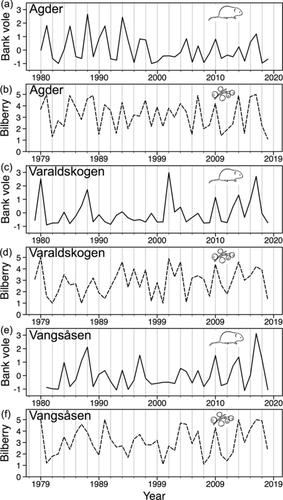当前位置:
X-MOL 学术
›
Ecol. Res.
›
论文详情
Our official English website, www.x-mol.net, welcomes your
feedback! (Note: you will need to create a separate account there.)
Bilberry seed production explains spatiotemporal synchronicity in bank vole population fluctuations in Norway
Ecological Research ( IF 1.7 ) Pub Date : 2021-01-12 , DOI: 10.1111/1440-1703.12204 Vidar Selås 1 , Erik Framstad 2 , Jørund Rolstad 3 , Geir A. Sonerud 1 , Tor K. Spidsø 4 , Per Wegge 1
Ecological Research ( IF 1.7 ) Pub Date : 2021-01-12 , DOI: 10.1111/1440-1703.12204 Vidar Selås 1 , Erik Framstad 2 , Jørund Rolstad 3 , Geir A. Sonerud 1 , Tor K. Spidsø 4 , Per Wegge 1
Affiliation

|
Population fluctuations of small rodents are often synchronized over larger areas (>100 km) than what could be explained by dispersal, suggesting that the synchronizing factor is weather‐related and possibly mediated through changes in food quality. Because bank vole (Myodes glareolus) populations usually peak 1 year after peaks in reproduction of the staple winter food plant bilberry (Vaccinium myrtillus), we tested for a possible link between food and spatial synchrony by comparing the synchrony in bank vole population indices and bilberry seed production indices between three study areas across about 20,000 km2 in South Norway during a four decade period (1979–2019). There were subperiods of spatial synchrony and asynchrony between the study areas in the fluctuations of bank vole numbers and bilberry seed production, with the latter part of the study period displaying more pronounced synchrony than the first and middle part. However, with a few marked exceptions, when vole fluctuations were spatially out of phase across study areas so was bilberry seed production. Thus, we conclude that bilberry seed production to a large extent explained the spatiotemporal synchronicity in bank vole population fluctuations. Although bilberry seed production seems to be a causal driver of vole fluctuations, it remains to be seen to what extent the chemical composition of bilberry plants influences vole performance. Finally, certain weather factors may still influence voles directly, or indirectly by triggering bilberry seed production.
中文翻译:

越桔种子生产解释了挪威银行田鼠种群波动的时空同步性
小型啮齿动物的种群波动通常在更大的区域(> 100 km)上被同步化,而不是用扩散来解释,这表明同步化因素与天气有关,并可能通过食物质量的变化来介导。由于河岸田鼠(Myodes glareolus)种群通常在主要的冬季食用植物越桔(Vaccinium myrtillus)繁殖高峰后1年达到峰值,因此,我们通过比较河田田鼠种群指数和越橘的同步性来测试食物与空间同步性之间的可能联系。三个研究区域之间约20,000 km 2的种子生产指数在四个十年期间(1979-2019年)在挪威南部。在河岸田鼠数量和越橘种子产量的波动中,研究区域之间存在空间同步和异步的子周期,研究期的后半段比第一和中间部分显示出更明显的同步性。但是,除了少数明显的例外,当整个研究区域的田鼠起伏波动在空间上不同相时,越桔种子的生产也是如此。因此,我们得出的结论是,越桔种子的产生在很大程度上解释了银行田鼠种群波动的时空同步性。尽管越桔种子的产生似乎是田鼠波动的原因,但仍有待观察的是,越桔植物的化学成分在多大程度上影响了田鼠的生长性能。最后,
更新日期:2021-01-12
中文翻译:

越桔种子生产解释了挪威银行田鼠种群波动的时空同步性
小型啮齿动物的种群波动通常在更大的区域(> 100 km)上被同步化,而不是用扩散来解释,这表明同步化因素与天气有关,并可能通过食物质量的变化来介导。由于河岸田鼠(Myodes glareolus)种群通常在主要的冬季食用植物越桔(Vaccinium myrtillus)繁殖高峰后1年达到峰值,因此,我们通过比较河田田鼠种群指数和越橘的同步性来测试食物与空间同步性之间的可能联系。三个研究区域之间约20,000 km 2的种子生产指数在四个十年期间(1979-2019年)在挪威南部。在河岸田鼠数量和越橘种子产量的波动中,研究区域之间存在空间同步和异步的子周期,研究期的后半段比第一和中间部分显示出更明显的同步性。但是,除了少数明显的例外,当整个研究区域的田鼠起伏波动在空间上不同相时,越桔种子的生产也是如此。因此,我们得出的结论是,越桔种子的产生在很大程度上解释了银行田鼠种群波动的时空同步性。尽管越桔种子的产生似乎是田鼠波动的原因,但仍有待观察的是,越桔植物的化学成分在多大程度上影响了田鼠的生长性能。最后,











































 京公网安备 11010802027423号
京公网安备 11010802027423号